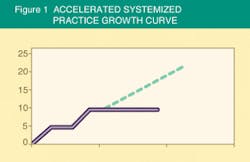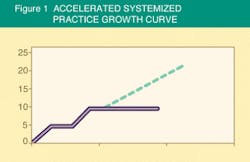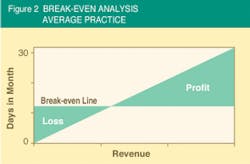HOW TO PROFIT FROM... practice analysis
A FLAT PRACTICE IS A DECLINING PRACTICE
Roger LEVIN, DDS, MBA
When I began consulting with practices throughout the United States in 1985, I found a mixture of offices with differing needs. However, back then, it was more common than not to work with practices that were very strong and growing financially, but which needed an overhaul of their management systems.
Today, we are seeing a changing trend in dental practices. While many practices still are growing, there is a far larger number that have hit a plateau and are not growing at all. Even practices that have experienced 10 or 15 years of continuous growth are discovering that they are beginning to hit certain plateaus. This increase in the number of nongrowing practices is becoming more significant.
I find this unfortunate because it indicates that recent changes in dentistry are having a dramatic impact on a large number of practices. The problem is not simply that dentistry has changed, but that these new and sometimes difficult challenges are causing many practices to slow down rather than take advantage of new opportunities.
A new client recently began a one-year program with us to implement all new management systems in the practice. In our initial conversation with this doctor, he indicated that his practice had been flat for the last four years. My response was that his practice was not flat, but actually was declining. He again explained his view that his practice was not declining, but merely flat. However, by the end of the conversation, the doctor began to understand that when a practice is flat, it actually is in decline.
Flat means decline
Many dentists do not realize that there is no such thing as a flat or practice plateau, but every business has what is known as a standard business cycle.
The four stages of the business cycle include:
Phase 1: Start - The start typically would represent the practice of a dentist who opened a practice from scratch. While this is becoming increasingly less common, most businesses are either started from nothing or purchased with a significant amount of outstanding debt. In either case, the actual business or practice is in a start-up phase and, therefore, generates very little in the way of revenue. This is why so many of our transition clients decide to purchase a practice instead of starting with no patients.
Phase 2: Growth - The second phase is growth. In many cases, we are talking about extremely rapid growth, regardless of whether the practice is started new or is purchased from another doctor. In either case, it is not unusual to see a new dentist experience a rapid growth phase.
The problem is that, back in 1985 and 2,100 consulting clients ago, the length of the growth phase was far longer than it appears to be today. We are noticing that the growth phase has shortened considerably for many practices, which is becoming a problem in offsetting the debt of opening or purchasing a new office.
Phase 3: Maturity - This is the phase where most dentists think their practices have gone flat. Practices are reaching maturity earlier than ever before, but this does not concern many doctors. Their feeling is that their practices are temporarily idle and will continue to grow sometime in the near future. Two misconceptions mark their thinking:
a. A flat practice actually is a declining practice in terms of real dollar purchasing power.
b. Steps are not being taken to accelerate the growth of a practice. Instead, many dentists simply "hang out," waiting for the next phase of growth to begin.
Phase 4: Decline - When I first began consulting and lecturing in the mid-1980s, I saw very few practices that actually were in decline. If the dentist was within a few years of retirement, a declining practice was more common. The reason that these practices declined was because the dentist had lost interest and the owner simply was waiting to get out of dentistry. Unfortunately, these dentists, because of their lack of interest and focus on the practice, allowed a very valuable asset to decline. During their careers, they had produced and saved enough money to retire without being concerned about obtaining maximum value in the sale of the practice.
Today, only 3 percent of all dentists can afford to retire at the age of 60. Our philosophy is that almost any dentist should be in a position to retire or at least be financially independent by the age of 55. It is a lack of proper management systems and poor financial planning that causes so many dentists to work years beyond their desire to do so.
However, the main point is that most practices, even 10 years ago, did not enter Phase 4 or the decline phase. Today, we are seeing many more practices that are in decline. If your practice has spent more than one year in the maturity or flat phase, it actually has entered Phase 4 and you have not realized it.
The reason you have entered Phase 4 is that if your practice income is the same as last year, the purchasing power of that income has declined. Dental inflation is higher than normal economic inflation in the United States and it will eat away at the purchasing power of the income you have produced. This is why producing the same income this year as last year actually represents an approximate 5- to 7-percent decline in today`s economy.
Once our new client began to realize that his practice was not flat, but in decline, he became very concerned about the long-term health of the practice. When you are concerned and willing to make changes, you can then take steps to truly make a difference.
Business law Number 1
Whether we like it or not, business has certain laws. A law is something that will happen whether we want it to or not. For example, look at the law of gravity. Suppose you have the most positive attitude, greatest intentions and strongest beliefs in the whole world. You believe you can fly. You go to the top of a 40-story office building and jump off. Despite the greatest attitude, intentions and beliefs on your part, you still are going to fall 40 stories because of gravity.
The same concept of law holds true in business and dentistry. The first law of business states: Your business will either grow or decline - it will not stay the same.
This law is applicable to almost every dental practice. If your practice is not growing, at some point, it will begin to decline. Some very specific reasons exist for such a decline, including:
1. Maximum Capacity
Many dentists think they have reached their maximum capacity and that they cannot perform any more dentistry. The truth is that the clients we see typically have at least a 30- to 50-percent potential for increasing their practices without expanding their hours or working harder. A great deal of this goes back to understanding that most practices schedule significantly below their potential and have other inefficiencies in their systems that result in poor time-and-scheduling management.
After a review of the five major business systems - 1) scheduling, 2) practice financial management, 3) patient finance/insurance/collections, 4) case presentation and 5) profitable hygiene programs, we find that most clients easily can increase their practice production by 30 to 50 percent.
2. New Patients
Many practices begin to see a decrease in the number of new patients. This results in a flattening of the practice.
Most practices start to flatten out for the first time about five years after starting up or having been purchased by an associate. The problem is that these plateaus are now coming earlier in practice cycles, due to the many changes in dentistry.
A second plateau typically will occur approximately four to five years later. Unfortunately, many dentists do not expect to see these plateaus and they accumulate significant debt thinking that the practice will continue to expand indefinitely.
Grow your practice
The minimum growth that a practice should experience annually is approximately 15 percent. While there may be a slight range of acceptability, we have found that anything below this amount represents a practice that is flattening out and heading towards a "real dollar" decline. The reason for this is that it simply costs more each year to run a dental practice. Therefore, real growth needs to hover around 13 to 15 percent.
1. One way to address this problem is by increasing fees. Obviously, you cannot increase your fees by 15 percent per year, but fees should be raised in conjunction with your expanding skills, reputation and ability to attract new patients. Those of you who have been reading my columns in Dental Economics know that I am an advocate of a lower-volume, high-profit style of practice. High profit is not an elitist term; it does point out the benefits of a well-controlled, high-profit, low-stress environment.
2. Another way to expand the practice is by increasing the number of new patients. One of the best methods for increasing the number of new patients is to replace any patients who leave the practice for any reason.
3. A third tool is to expand the services you offer. As new opportunities arise in dentistry, it is essential that you include them in your list of services.
Why is growth so important in dentistry? After all, there are some dentists who are comfortable and fairly satisfied with the size of their practices.
The problem arises when these individuals do not recognize that comfortable today is no guarantee of comfortable tomorrow. Dentistry is a rapidly and radically changing profession.
We strongly advocate a regular evaluation of your break-even point or what we call a Obreak-even analysis.O As you can see in Figure 2, most practices do not break even until approximately 20 days into the month.
By applying the proper business principles, streamlining overhead and analyzing each area of expense in your practice, you can reduce the number of days it takes to break even. (See Figure 3.)
That is why achieving real growth is important. Simply being comfortable with a practice that is flat is a danger sign because the practice actually is declining.
Anyone can continue to grow a practice. With growth, the average dentist can retire approximately six years earlier with increased total, lifetime practice revenues of between $4 million and $6 million.


